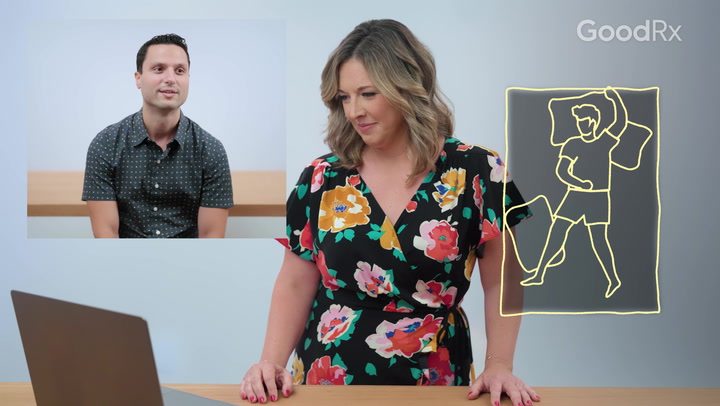
What Can Weighted Blankets Help With?
Key takeaways:
Weighted blankets are designed to provide comforting pressure to your body, similar to what you might experience during a massage or while cuddling up with a loved one.
They’re often recommended as a therapeutic tool to help people deal with problems such as anxiety, insomnia, and chronic pain.
People with certain conditions, such as asthma or diabetes, should talk to their healthcare provider before using weighted blankets, since they might affect breathing or circulation.
Weighted blankets may look like a regular quilt or bedspread, but they have a special ingredient. They’re packed with beads, pellets, or other heavy fillings meant to leave you rested and relaxed.
The special design turns everyday fabric into a therapeutic security blanket. But do weighted blankets really help people, and are they right for you? Keep reading to learn more.
How do weighted blankets work?
Have you ever cuddled up with a friend, pet, or significant other? If so, you might have felt calmer and more connected to your loved one. The sensations of touch and pressure trigger chemicals to be released in your body. These chemicals — like oxytocin — can help you feel happier and less anxious.
Save over 40% on Qsymia with GoodRx
Discover the once daily Qsymia for weight management. Qsymia is for adults and children 12-17 in combination with a healthy diet and regular exercise.

Since weighted blankets are heavier than regular blankets, they press against the body like a hug. This is called deep pressure stimulation.
While more research is needed, it’s possible that weighted blankets trigger the same pleasant feelings as cuddling or being embraced. And because you feel calmer and more secure, the blankets may decrease stress.
Who uses weighted blankets?
People often use weighted blankets when they are anxious or overwhelmed. They might wait to use the blankets until they really need them. Others find them helpful for sleep and use them every night.
Medical settings sometimes use this tool as part of treatment. One study in a mental health hospital showed that weighted blankets helped with anxiety and stress. Experts in the study said they hoped that this tool could decrease the need for certain medications.
One study that took place in an assisted living facility found that residents fell asleep faster when they used a weighted blanket. They also tended to worry less.
Another study found that people who used weighted blankets during chemotherapy treatments reported less anxiety. There’s even data that shows people who use weighted blankets during dental procedures experience less anxiety.
Read more like this
Explore these related articles, suggested for readers like you.
Who are weighted blankets good for?
Experts don’t know for sure who may benefit the most from weighted blankets or what conditions they might help with. Although they’re popular in multiple settings, research is limited.
What we do know is that weighted blankets might be helpful for people with:
Dementia
Autism
Anxiety
Depression
Attention-deficit hyperactivity disorder (ADHD)
Even someone without these conditions may find comfort from weighted blankets. It’s not necessary to have a certain diagnosis to use them. Benefits will vary depending on the person and situation.
Do weighted blankets help with autism?
Some people with autism may use weighted blankets because they’re sensitive to touch. They may want more or less physical contact with other people but have trouble managing it. They might sometimes become restless, wanting more stimulation.
Temple Grandin, a researcher and autism advocate, struggled with this problem herself. She wanted to feel hugs and touch, but she felt overwhelmed being so close to someone. So she invented a device called the hug machine. It mimics the feeling of another person hugging you but allows you to control the experience.
Grandin’s invention and research helps us understand how weighted blankets may work. Since then, experts have found additional evidence that weighted blankets may help with sensory sensitivities and sleep.
Who should not use weighted blankets?
Heavy blankets might not be appropriate for people with certain conditions. Those who have the following conditions should check with a healthcare provider first:
Asthma
Chronic obstructive pulmonary disease (COPD)
Sleep apnea
Diabetes
Any other condition that affects breathing or circulation
People shouldn’t use a weighted blanket if they can’t easily remove it. This may include people with impaired mobility or dementia.
Young children should also avoid weighted blankets until they can easily remove them. Infants should never use weighted blankets. They can get trapped underneath, which can lead to sudden infant death syndrome (SIDS).
People with claustrophobia (a fear of confined spaces) or other mental health conditions might find the blankets uncomfortable. However, a therapist may also recommend the blankets as a therapeutic tool to help with these issues.
If you have concerns about physical or mental health symptoms, talk to your healthcare provider before using a weighted blanket.
How do I choose a blanket that’s right for me?
Weighted blankets come in multiple styles, sizes, and weights. They also vary in price. Weighted blankets typically cost between $50 and $250.
If you decide to buy one, you’ll want to make sure the weight is safe for your body. As a general rule, the blanket should be around 10% of your body weight. So if someone weighs 100 pounds, they should look for a blanket around 10 pounds. You should also be able to safely lift the blanket off of yourself.
Weighted blankets come with different fillings that provide slightly different sensations. If possible, test out blankets before you choose one. If you’re not able to do so, read through reviews online to see which features you might like best.
Don’t overlook the style and color of your blanket. Having a blanket that’s visually appealing may encourage you to use it more often.
The bottom line
While more research is needed, many professionals consider weighted blankets a good therapeutic tool. They may help some people with anxiety, ADHD, autism, depression, and other mental or physical health conditions. The only way to know for sure if a weighted blanket will work for you is to try one for yourself. You can find weighted blankets in local retail stores and online.
Why trust our experts?



References
Arky, B. (n.d.). Sensory processing issues explained. Child Mind Institute.
Baumgartner, J. N., et al. (2022). Widespread pressure delivered by a weighted blanket reduces chronic pain: A randomized controlled trial. The Journal of Pain.
Becklund, A. L., et al. (2021). Using weighted blankets in an inpatient mental health hospital to decrease anxiety. Journal of Integrative Medicine.
Chen, H. Y., et al. (2013). Physiological effects of deep touch pressure on anxiety alleviation: The weighted blanket approach. Journal of Medical and Biological Engineering.
Eckstein, M., et al. (2020). Calming effects of touch in human, animal, and robotic interaction — Scientific state-of-the-art and technical advances. Frontiers in Psychiatry.
Eron, K., et al. (2020). Weighted blanket use: A systematic review. American Journal of Occupational Therapy.
Gee, B., et al. (2017). Efficacy of weighted blankets for children with autism spectrum disorder, sensory overresponsivity, and sleep disturbance. American Journal of Occupational Therapy.
Grandin, T. (1992). Calming effects of deep touch pressure in patients with autistic disorder, college students, and animals. Journal of Child and Adolescent Psychopharmacology.
Hjort Telhede, E., et al. (2022). Nursing staff's experiences of how weighted blankets influence resident's in nursing homes expressions of health. International Journal of Qualitative Studies on Health and Well-Being.
Locknear, F. (n.d.). Average cost of a weighted blanket. The Cost Guys.
Mullen, B., et al. (2008). Exploring the safety and therapeutic effects of deep pressure stimulation using a weighted blanket. Occupational Therapy in Mental Health.
Noyed, D. (2022). How heavy should a weighted blanket be?. Sleep Foundation.
Noyed, D. (2022). Weighted blanket benefits. Sleep Foundation.
Vinson, J., et al. (2020). Weighted blankets: Anxiety reduction in adult patients receiving chemotherapy. Clinical Journal of Oncology Nursing.




























